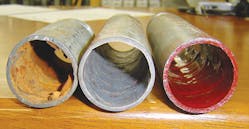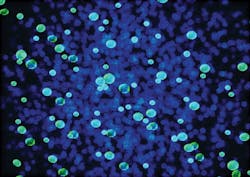By Holly Neuhaus
Many people think water-related diseases only happen in developing countries, not realizing the potential for catching a life-threatening water disease is knocking at their front door. There are several deadly waterborne diseases looming but the most infamous is Legionnaires’ disease bacteria (LDB). LDB is now the primary source for waterborne disease outbreaks and deaths in the U.S., according to the U.S. Centers for Disease Control & Prevention. LDB can be found in cooling systems, which are in nearly every industrial facility or large building facility. With the potential severity of water diseases looming, the American National Standard Institute (ANSI) and the American Society of Heating, Refrigerating and Air-Conditioning Engineers (ASHRAE) passed a new standard, ANSI/ASHRAE 188, that holds building owners and facility managers accountable for their building’s water systems, including cooling systems.
The ANSI/ASHRAE 188 standard is the first step towards safe water systems nationwide, however, what does this new standard mean for owners and facility managers of industrial buildings? The newly approved standard’s purpose is to minimize water-related diseases by ensuring that building owners and managers implement a risk management plan for their building’s water systems.
Some water systems are more at risk than others. Cooling towers are more at risk for acquiring LDB growth that could lead to an outbreak of Legionnaires’ disease. ANSI/ASHRAE 188 isn’t just a standard for building owners and facility maintenance managers to ignore: it is backed by the Environmental Protection Agency and local water protection authorities and is likely to be added to the National Plumbers Code.
To comply with the standard, owners and facility managers must implement four key standards:
- Meet minimum standard risk management requirements for building water system (potable and non-stable) as specified by the standard.
- Conduct a building survey to identify risk factors for water disease, contamination, and occupant exposure.
- Appoint a team of staff to develop and implement a water management program for risk management of the building’s water system.
- Develop control strategies for the water management program as necessary to meet the 188 Standard.
The development of the new standard brings to light more than a few questions about how to solve waterborne diseases, specifically in cooling systems. For example: How does LDB occur in cooling systems? How can HVAC systems be maintained properly so there is not any LDB growth? How can one treat a contaminated system?
The most critical step in stopping Legionnaires’ disease outbreaks in cooling systems is awareness of the conditions that promote LDB growth and following through with maintenance plans that mitigate those conditions.
According to the Occupational Safety and Health Administration (OSHA), for a Legionnaires’ disease outbreak to be linked directly with the cooling tower system, LDB contaminated water must enter the system, be converted into a fine spray, and be delivered to the building’s occupants. LDB can only live in water but this also includes tiny airborne droplets, which is how people can contract the disease.
There are specific internal places in a cooling system that may lead to the distribution of LDB in a building: HVAC system humidifiers, which are a source of aerosol exposure; sprays or misters that are used as humidifiers such as sumps; a water coil that directly leaks into the supply air stream; air-to-air heat exchanger leaks, which may mix the wet air stream with the supply air; and improperly drained condenser pans.
Legionella thrives in warm water. Often algae and scale present in a cooling tower water pipe system are distributed to the rest of the building. Maintenance failures can cause stagnant water to heat up in the sunlight, which can become an ideal environment for LDB growth. In addition to standing water in a cooling system, internal pipe scale is a breeding ground for biofilm that contains LDB to build up over time.
Monitoring pathogens from biofilms in cooling tower systems is the best way to prevent LDB from spreading. Maintenance options such as camera pipe inspections are an ideal service to identify if there is a significant amount of scale and algae build-up that may promote LDB growth. Once the scale is identified, pipe cleaning tools can be used to score the inside of the pipe, which separates the scale build-up from the internal pipe. For a more long-term solution, epoxy coating pipe lining can be used to stop scale and algae build-up. It provides a smooth barrier between the pipe and water such that LDB biofilms cannot attach to the cooling system’s pipes.
In the unfortunate event that a cooling tower system becomes contaminated with a waterborne disease such as LDB, there are steps to contain the bacteria from spreading throughout the facility. According to OSHA, eliminating all water leaks and removing all standing water found in the system can mitigate further contamination. In addition, replacing or eliminating any water-damaged insulation in the system that could be carrying LDB ensures that everything the contaminated water has touched is removed from the facility.
The ANSI/ASHRAE 188 standard is just the beginning of new water system standards that will likely be implemented in decades to come. This affects not just traditional plumbing or potable pipelines but overlooked systems such as cooling towers. The internal piping of a cooling system may seem like a small piece of the puzzle compared to a large facility but it cannot be overlooked due to its potential for carrying Legionella bacteria. In the case of cooling systems, awareness of conditions that promote LDB growth, in addition to effective maintenance plans and partnerships with businesses that have the technology to inspect, clean, and line pipes, will help facilities minimize their chances of a Legionella outbreak that could affect their occupants.
About the Author: Holly Neuhaus is the marketing coordinator for Specialized Pipe Technologies, a leading installer of innovative water and wastewater pipe renewal solutions. Neuhaus works closely with municipalities, utilities, plumbing and mechanical companies to identify their individual infrastructure renewal needs as it pertains to pipe renewal vs. replacement. She can be contacted via e-mail at [email protected].




